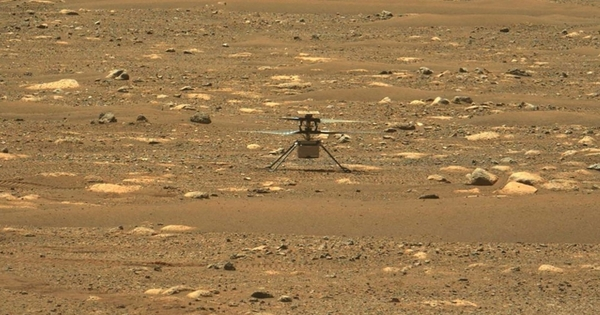A study of Martian helicopter dust dynamics would likely focus on the interaction between the rotor blades of a helicopter and the Martian surface. Mars has a thin atmosphere, which means that dust can accumulate on the surface and be easily stirred up by the rotor blades of a helicopter. This dust can pose a hazard to the helicopter’s operation, potentially causing damage to the blades or interfering with the aerodynamics of the vehicle.
The first real-world study of Martian dust dynamics based on Ingenuity’s historic first flights on the Red Planet has been completed, paving the way for future extraterrestrial rotorcraft missions. The research could help NASA’s Mars Sample Return Program, which will retrieve samples collected by Perseverance, or the Dragonfly mission, which will launch in 2027 to Titan, Saturn’s largest moon.
To study these dynamics, researchers might use simulations to model the behavior of dust particles in the Martian atmosphere and on the surface. They might also conduct experiments in a controlled environment, such as a wind tunnel, to observe how dust particles interact with the blades of a model helicopter. Additionally, researchers could use data collected by a real Mars helicopter to study the effects of dust on its flight.
Mars is a dusty world. Dust is a constant challenge for research missions, from tiny dust devils to massive storms that shroud the planet. That was especially true for Ingenuity, the rotorcraft that has been exploring Mars alongside NASA’s Perseverance rover since February 2021. The first real-world study of Martian dust dynamics based on Ingenuity’s historic first flights on the Red Planet has now been completed by researchers at Stevens Institute of Technology, the Space Science Institute, and the Jet Propulsion Laboratory, paving the way for future extraterrestrial rotorcraft missions.
The work, reported in the December 2022 issue of Journal of Geophysical Research: Planets, could support NASA’s Mars Sample Return Program, which will retrieve samples collected by Perseverance, or the Dragonfly mission that will set course for Titan, Saturn’s largest moon, in 2027.
It was exciting to see the Mastcam-Z video from Perseverance, which was taken for engineering reasons, ended up showing Ingenuity lifting so much dust from the surface that it opened a new line of research.
Mark Lemmon
“There’s a reason that helicopter pilots on Earth prefer to land on helipads,” said Jason Rabinovitch, a co-author and assistant professor at Stevens. “When a helicopter lands in the desert, its downdraft can stir up enough dust to cause a zero-visibility ‘brownout’ — and Mars is effectively one big desert.”
Rabinovitch has been involved with NASA’s Ingenuity program since 2014, joining the Jet Propulsion Laboratory shortly after the concept was first pitched to NASA and developing the first theoretical models of helicopter dust lifting in dusty Martian environments. Rabinovitch continues to collaborate with JPL at Stevens, where he studies plume-surface interactions during a spacecraft’s powered descent. He also simulates supersonic parachute inflation and geophysical phenomena like Enceladus plumes.
It’s difficult to study dust dynamics on another planet, according to Rabinovitch. “Space is a data-deficient environment. Because it is difficult to send videos and images back to Earth, we must make do with what we have.”

To overcome this obstacle, Rabinovitch and colleagues at JPL used advanced image-processing techniques to extract data from six helicopter flights, all of which were captured in low-resolution videos by Perseverance. The researchers were able to calculate the size and total mass of dust clouds kicked up as Ingenuity took off, hovered, maneuvered, and landed by identifying tiny variations between video frames and the light intensity of individual pixels.
The results were within striking distance of Rabinovitch’s engineering models, which was a remarkable achievement given the team’s limited information back in 2014, when Rabinovitch and his colleagues were writing back-of-the-envelope calculations to support the original design of Ingenuity.
The research shows that, as predicted, dust is a significant consideration for extra-terrestrial rotorcraft, with Ingenuity estimated to have kicked up about a thousandth of its own mass (four pounds) in dust each time it flew. That’s many times more dust than would be generated by an equivalent helicopter on Earth, though Rabinovitch cautions that it’s tricky to draw direct comparisons.
“It was exciting to see the Mastcam-Z video from Perseverance, which was taken for engineering reasons, ended up showing Ingenuity lifting so much dust from the surface that it opened a new line of research,” said Mark Lemmon, senior research scientist at the Space Science Institute Mars Science Laboratory and first author of the study.
“When thinking about dust on Mars, you have to consider not only the lower gravity, but also the effects of air pressure, temperature, and air density — there’s a lot we don’t yet fully understand,” Rabinovich said. Still, that’s what makes studying Ingenuity’s dust clouds so exciting, he says.
A better understanding of brownouts could help NASA extend future robotic missions by keeping solar panels operational for longer periods of time, or it could make it easier to land delicate equipment safely on Mars’ dusty surface. It may also shed light on the role of wind and wind-carried dust in weather patterns and erosion, both on Earth and in extreme environments throughout the Solar System.















